
Chapter 9 & 10: Photosynthesis/Cellular Respiration >
Photosynthesis
Photosynthesis is a process that harnesses energy from the sun to convert it into energy-containing substances that can be used for fuel. One of the most essential substances that cells use to store and release energy is called adenosine triphosphate, or ATP. It consists of adenine, ribose (5-carbon sugar), and 3 phosphate groups.
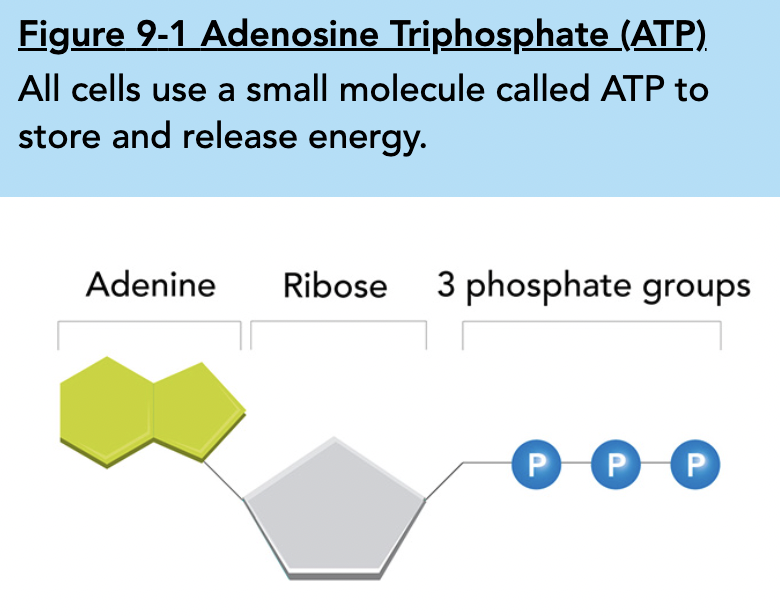
Adenosine diphosphate is a compound similar to ATP, but it has 2 phosphate groups instead of 3. When a cell has available energy, it can store small amounts of it by adding phosphate groups to ADP to produce ATP. This energy can then be released by breaking the chemical bonds in the 2nd & 3rd phosphate groups. So basically, ATP is like a rechargeable battery.
In summary, ATP is like a fully charged battery, while ADP is partially charged, and can be charged when phosphate groups are added.
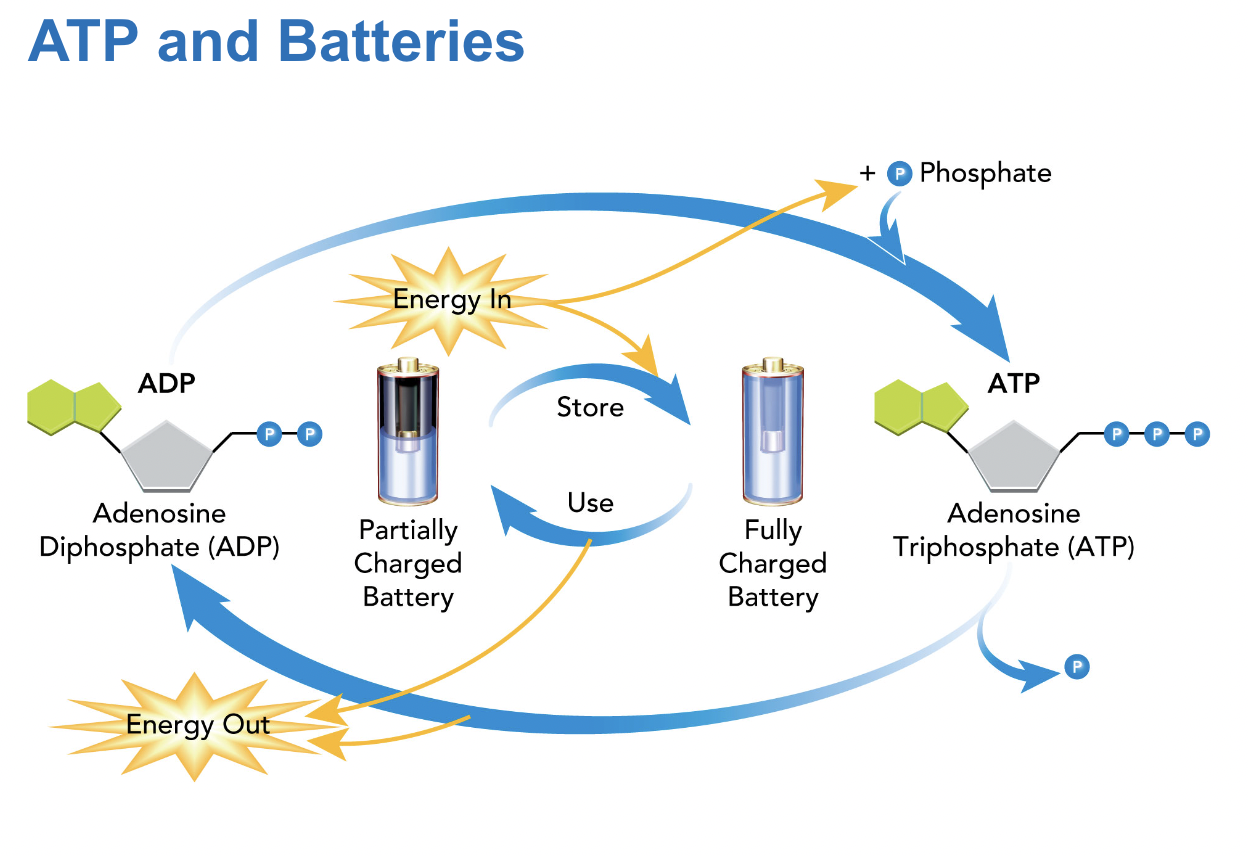
ATP is used for carrying out active transport, such as with sodium-potassium pumps, where membrane proteins pump sodium ions out of the cell, and potassium ions into it. ATP is also the motor for contracting muscles such as the wavelike movement of cilia and flagella, as well as the light of a firefly.
“In the process of photosynthesis, plants convert the energy of sunlight into chemical energy stored in the bonds of carbohydrates.”
Chlorophyll and Chloroplasts
Photosynthetic organisms capture energy from sunlight with pigments-- principally with chlorophyll,
which reflects green light, but absorbs light from other regions in the visible spectrum.
Accessory pigments reflect colors in other areas of the spectrum such as orange and red (helping chlorophyll maximize the amount of light energy absorbed from the sun), which is why these colors appear in fall.
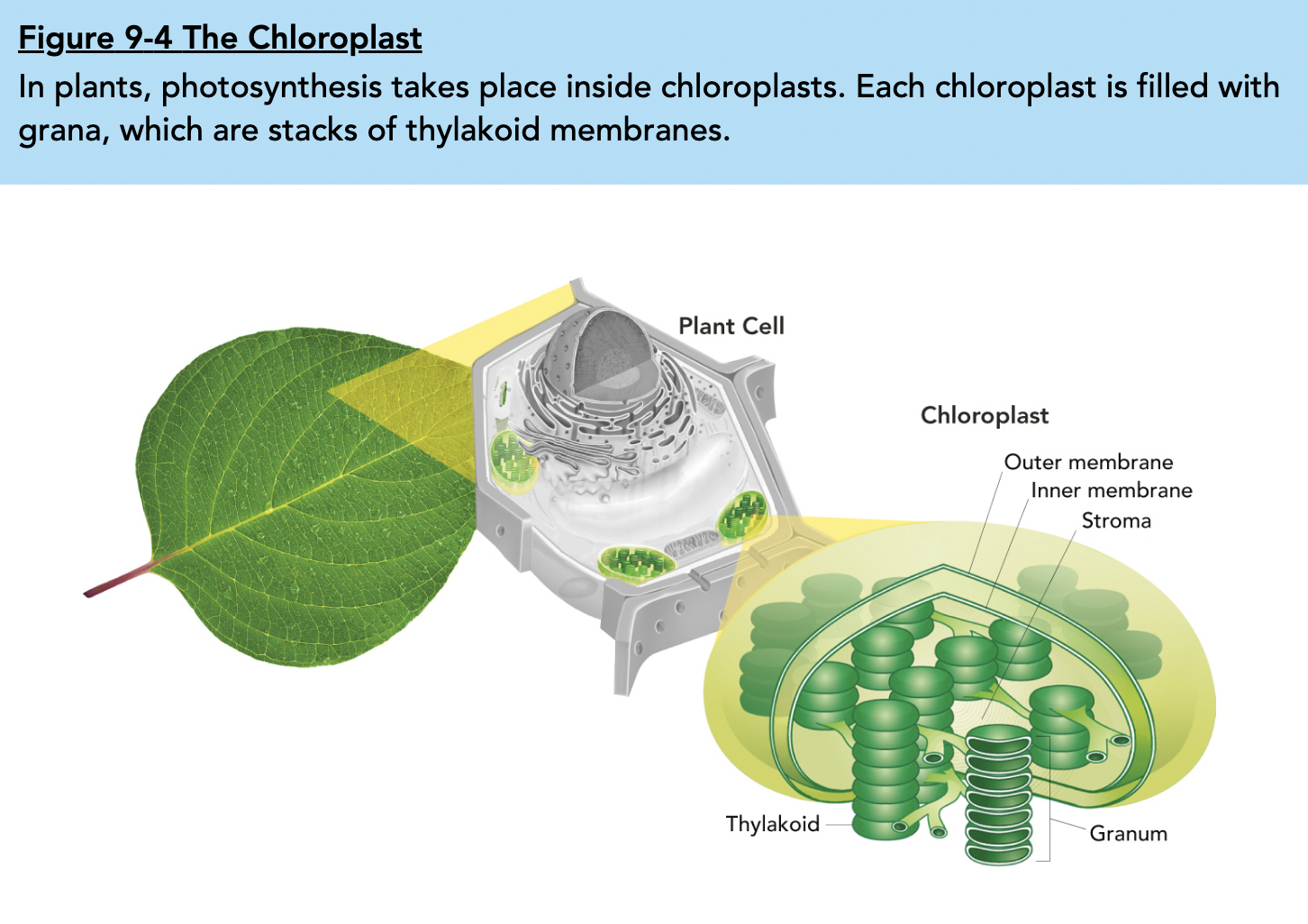
Thylakoids are saclike chlorophyll-containing membranes, and in a stack, are referred to as grana. The fluid within the chloroplast is known as the stroma.
Electrons produced by chlorophyll require a special "carrier" called an electron carrier, a compound that accepts electrons and transfers them (and their energy) to another molecule.
NADP+ (nicotinamide adenine dinucleotide phosphate) is one of these compounds, which holds two electrons and a hydrogen ion in order to convert it into NADPH. With this, energy from sunlight can be trapped in chemical form, and the high-energy electrons can then be used to build sugars.
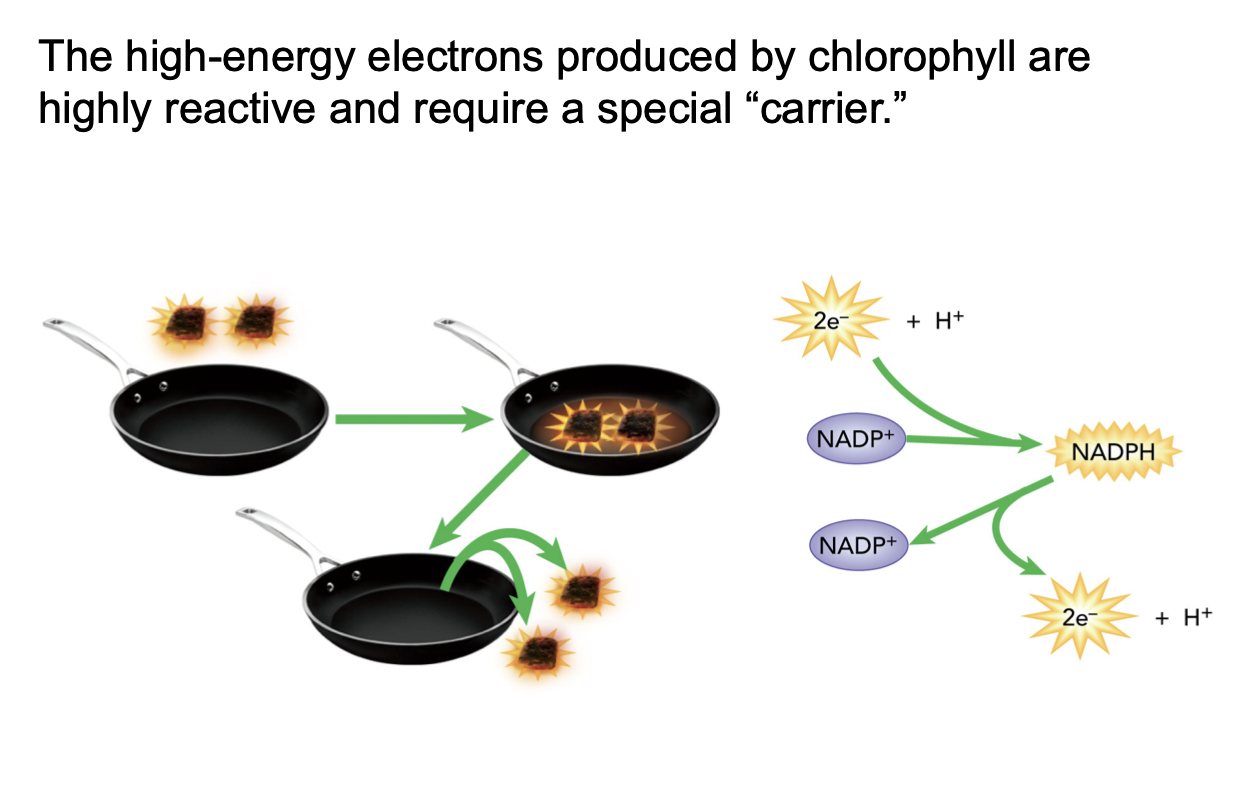
Photosynthesis uses the energy of sunlight to convert water and carbon dioxide (low-energy reactants) into high-energy sugars and oxygen (products) ……………..
Photosynthesis involves two sets of reactions:
Light-dependent reactions
require the direct involvement of light and light-absorbing pigments
Light-independent reactions
use ATP and NADPH molecules produced in the light-dependent reactions to produce high-energy sugars from carbon dioxide 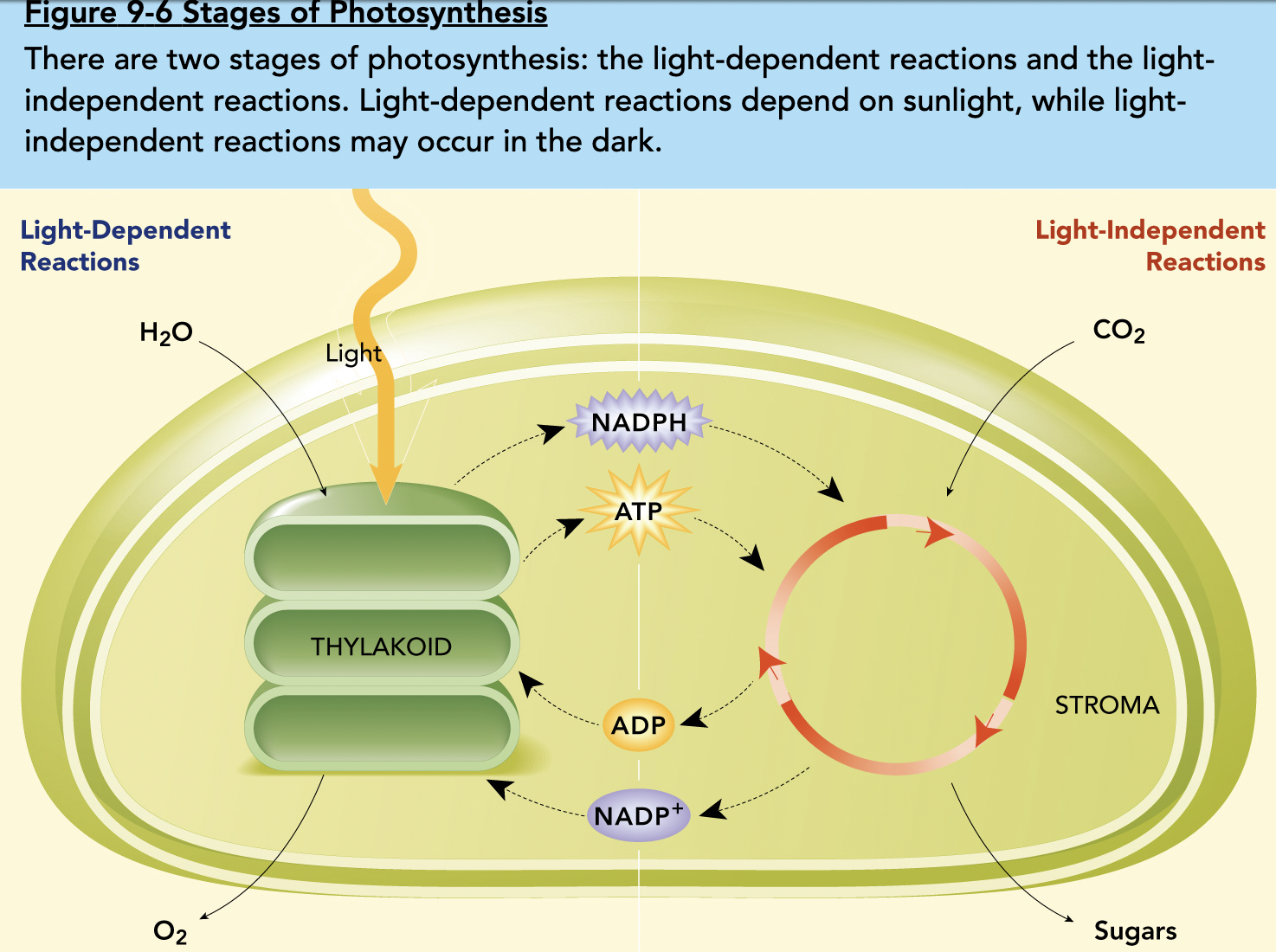
Light-dependent reactions use energy from sunlight to convert ADP and NADP+ into the energy and electron carriers ATP and NADPH. These reactions also produce oxygen as a by-product. Thylakoids contain clusters of chlorophyll, known as photosystems, which are surrounded by accessory pigments. These photosystems absorb sunlight and generate high-energy electrons that are passed to electron carriers within the membrane. Photosystem II (despite its name, this process occurs before photosystem I since it was discovered after), is where light-dependent reactions begin. Light is absorbed, raising electrons to a higher energy level, which are then passed to the electron transport chain. As these electrons continue to pass, the thylakoid membrane is able to provide new electrons (to replace the ones lost) from water molecules.
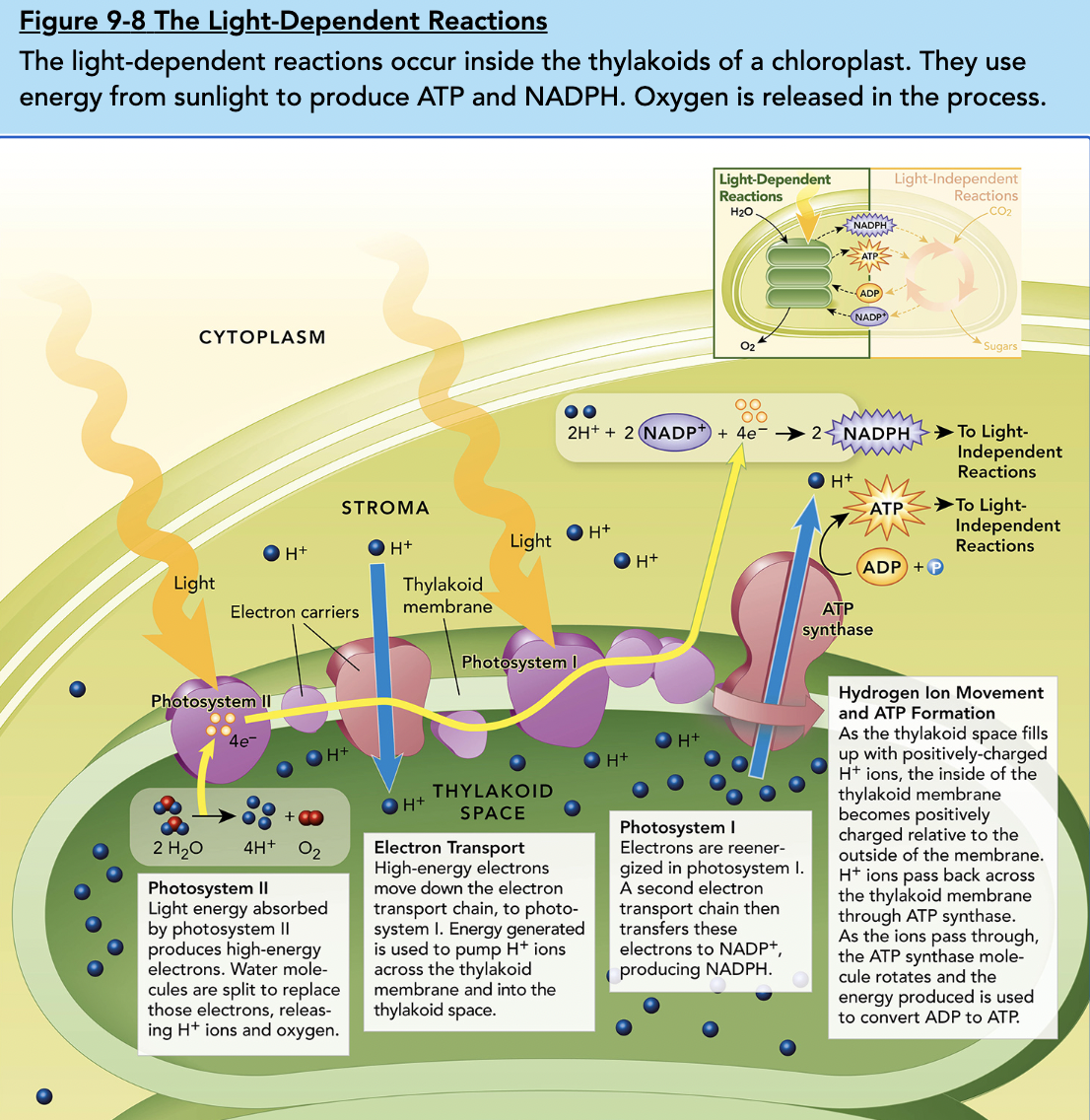
Light-independent reactions (Calvin cycle) then use the ATP and NADPH molecules to produce high-energy sugars from CO2.
-Energy for this process is supplied by compounds from light-dependent reactions. Six molecules of CO2 are used to produce a single 6-carbon sugar molecule.
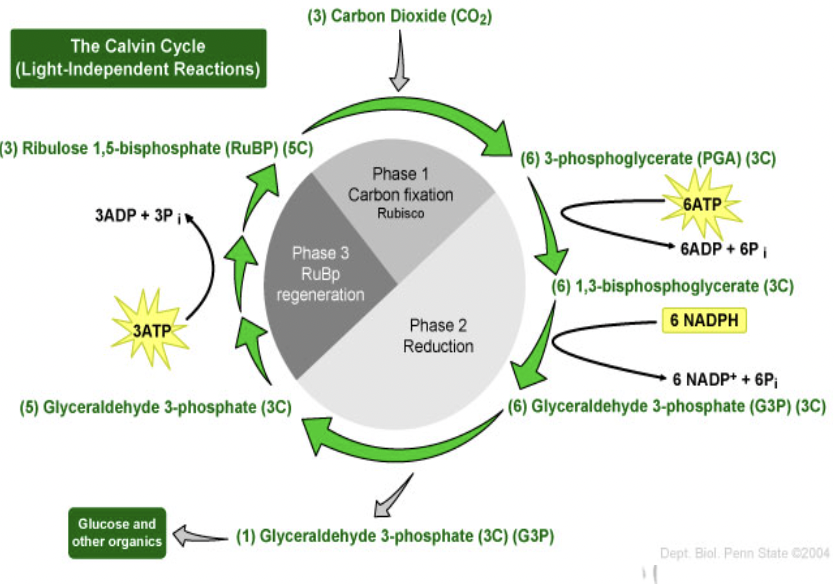
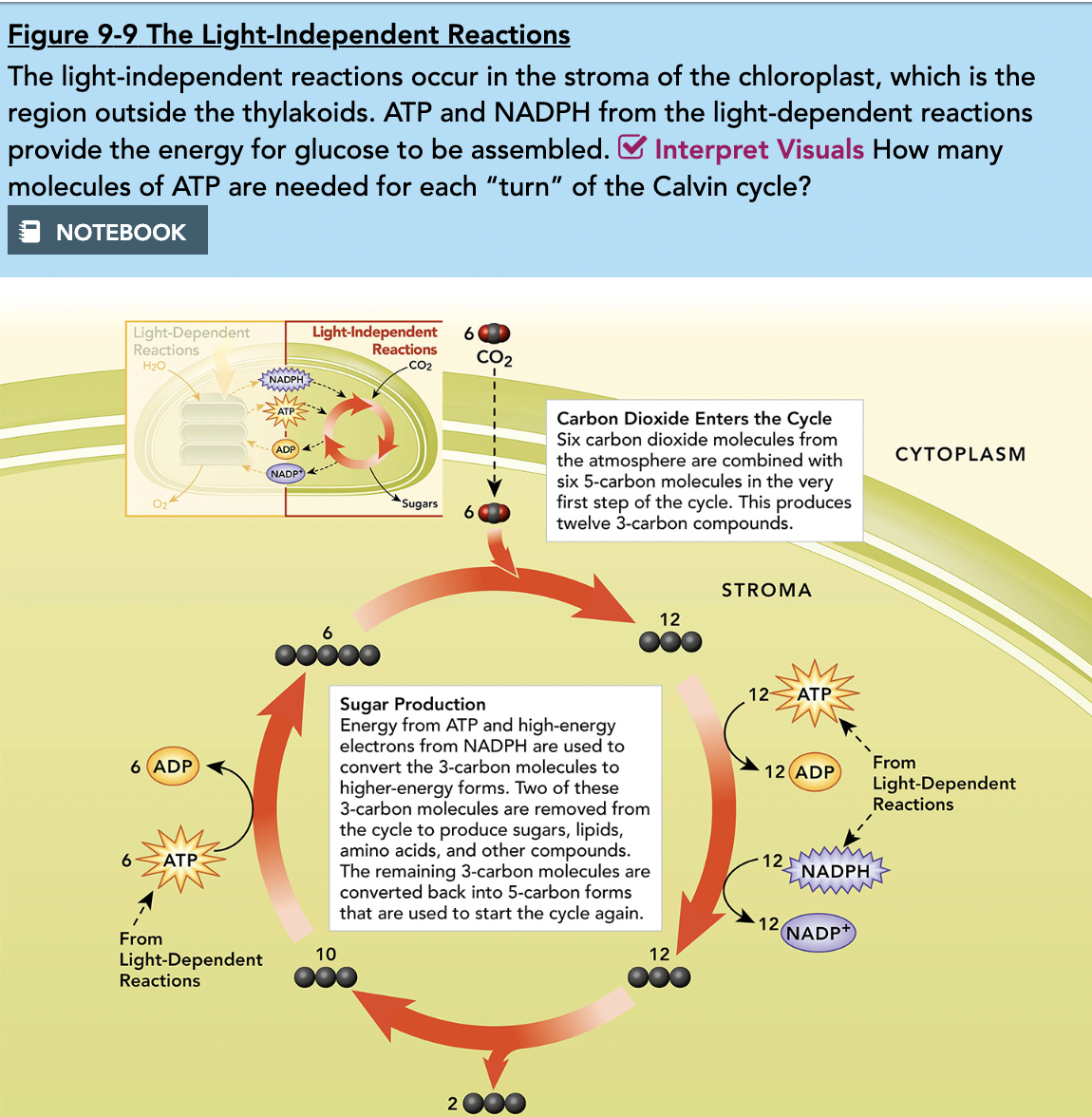
Chemiosmosis is when H+ ions (from split water) that have been pumped into the thylakoid space have been accumulating so that there is an uneven concentration.
Carbon-Fixation is when CO2 is added to organic compounds. First, CO2 enters the stroma, and rubisco (enzyme) combines the CO2 with a 5-C sugar (Ribulose biphosphate, RuBP), this then creates a 6-carbon compound. This cycle occurs 6 times.
Inputs | Outputs | |
|---|---|---|
Light Independent (stroma) | ATP, NADPH, CO2 | Sugar |
Light Dependent (thylakoid membrane) | Light, H2O | NADPH, ATP, O2 |
Cross Section of a Leaf
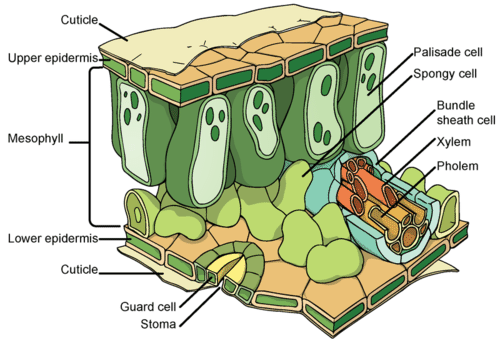
Stoma: openings are holes in the bottom of the leaf, guarded by guard cells. They control whether or not the holes stay open or if they’re going to shut (water pressure allows this to happen).
On a dry day, these holes fill with water and close to prevent additional water lost
On a moist, humid day, these openings will stay open so the water in the air can enter, and oxygen can leave
Xylem tissue distributes water/minerals from the roots to various areas of the plant, and the phloem carries food from the leaves to the roots: water goes down, and food goes up.
Cellular Respiration
When transferring electrons and when molecules are receiving electrons, its called a redox reaction
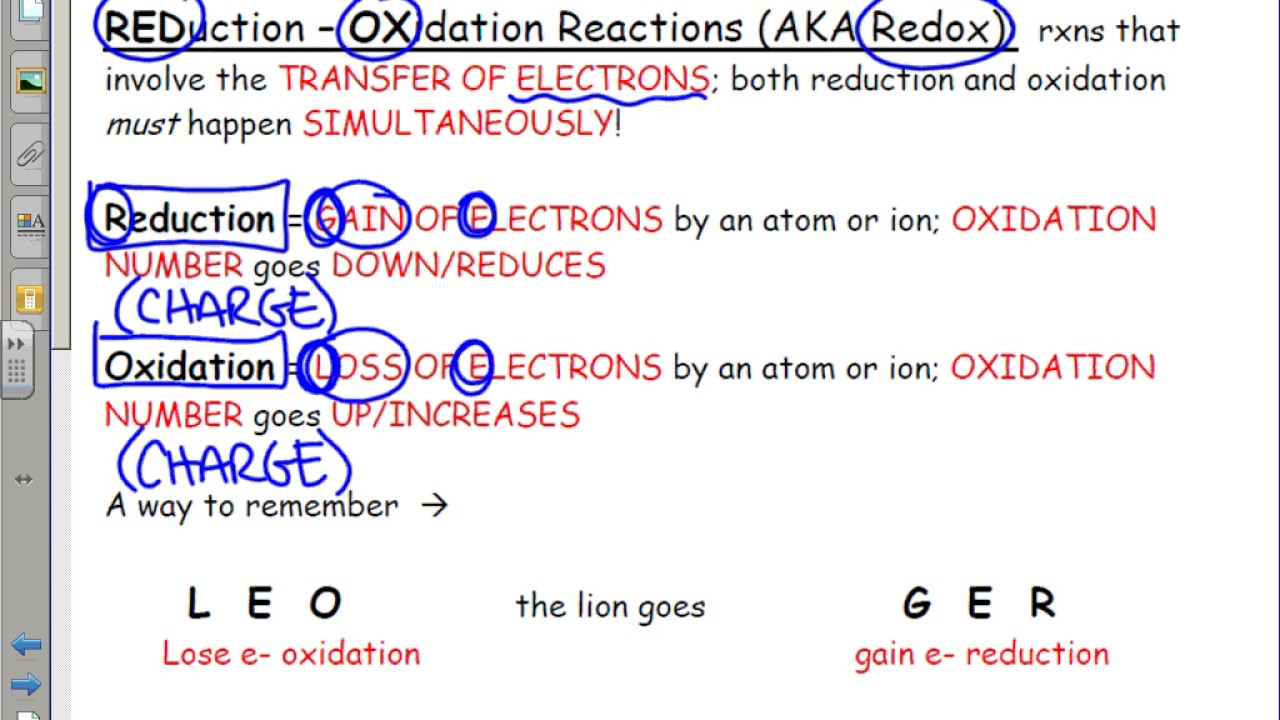
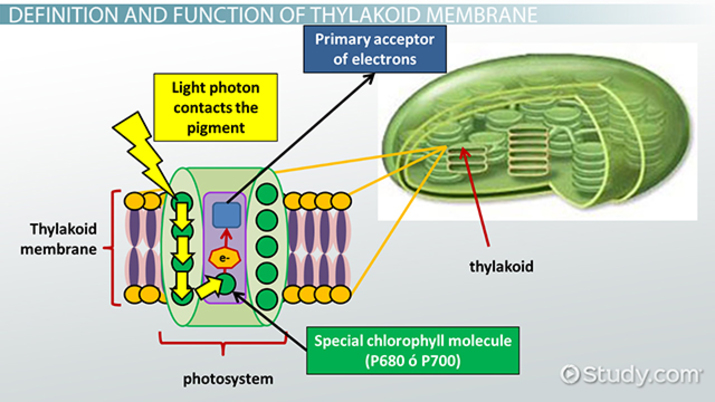
An electron transport chain is a controlled passing of electron
Series of molecules that excited electrons pass along to release energy
Releasing energy pumps proton into thylakoid space
Photolysis
splitting of water during photosynthesis
H2O>O+2H++2e-
electrons go to photosystems, protons stay in thylakoid space, oxygen is released as a waste product
photosystem I is the rest station to boost the energy level so it can go down the next step of electron transport chain
Photostbtgesus Ciebxyme
Ferrodoxin transfers electrons to the NADP+ in the stroma
Carrier ion
Picks up H+ and excited electrons from ETC to become NADPH
Identify how organisms get energy
How does cellular respiration work?
Process of energy conversion that releases energy from food in the presence of oxygen
The chemical summary of cellular respiration is Oxygen + Glucose > Carbon Dioxide +Water + Energy
6O2+C6H12O6 > 6CO2+ 6H2O + Energy
Enzyme controlled reactions that allow the slow release of glucose so that you dont burst into flames when you eat
Glycolysis
enters a chemical pathway known as glycolysis. A small amount of energy is released
Krebs Cycle
A little more energy is converted form the carbon sugars, releasing the energy in the form of ATP, Co2 is the waste
Occurs inside of the mitochondria, specifically the matrix
Electron Transport
Inner membrane, where the proteins in the electron transport chain is found
using oxygen, water is produced
majority of the ATP made
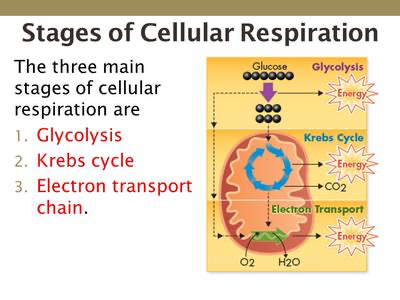
Photosynthesis and cellular respiration can be though of as “opposite processes” (mrs Alvarez disagrees when it is worded this way), the products of one become the reactants of the other
Integral part of the carbon cycle
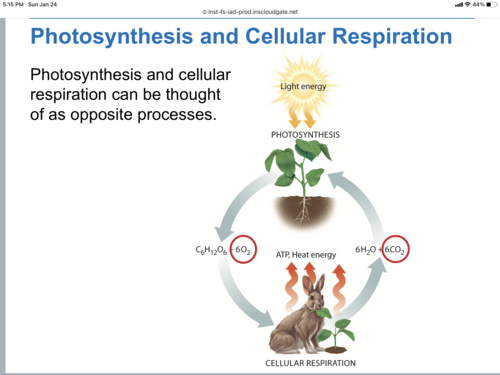
Oxygen + glucose > carbon dioxide + water + energy
Respiration requires a cell to exchange gases, we need oxygen within the cell, and carbon dioxide is produced as a waste.
Respiration: breathing on macro scale
Cellular respiration we have two different processes, based on whether or not they require oxygen to occur
Aerobic
Where it all happens (mitochondria)
Matrix- mitochondria’s cytoplasm
Glycolysis happens in the cytoplasm, anarobic
Formation of acetylyclA cytoplasm to matrix
Citric Acid Cycle (Krebs) occurs in the mitochondria matrix
ETC (inner membrane_
chemiosmosis
Using a protein gradient that we built up to pass it down
Store energy atp- adenosine triphosphate
collect hydrogen: Nadh- nicotamide adenine dinuceuotide
FADH2
Redox Reactions
Oxidation-reduction reactions transfer electrons from 1 substance or another glucose is oxidized during cellular respiration losing electrons to oxygen
Oxygen is reduced during cellular respiration accepting electrons and hydrogen from glucose
(glucose: oxidized, oxygen: reduced)
Anaerobic- Glycolysis
Step 1: Glycolysis
Series of 10 enzymes catalyzed reactions
Single glucose split into 2 pyretic acid molecules
One 6-C sugar > two 3c sugars
2 categories of reactions -use app, yield app and NADH
Anaerobic, occurs in the cytoplasm
An energy-releasing process uses 2 App reduces 2 Arp and 2 NADH
one reaction removes 4 electrons and passes them to NADH (each NADH accepts a pair of electrons
Very fast and doesn’t require O2
Reactants: glycose 2 atp
Products: 2 pyretic acid, 2 NADH, 4 ATP
Next step: 90% of energy in glucose still unused
so the acetyl CoA bridge helps us break it down further
2 pyretic acid molecules enter bridge
-cytoplasm > Matrix
Degraded by removal of C
Creates acetic acid
Combines with Coenzyme
Forms complex Acetyl CoA
starts with 2 pyruvates
ended with acetyl
2 co2
2 NADH
Step 3 Krebs cycle
Series of eight enzyme controlled steps
formation of oxaloacetate and citric acid
Final stage in the oxidation of carbohydrates, 2 acetyl coA enter cycle, one at a time
coenzyme a released
acetyl combines with oxaloacetate, making citric acid
Reactants: Acetly Coa
Products:
Where did all the H+ (NADH and FADH molecules) go?
step 4: electron transport chain
-series of molecules that excited electrons pass along, to release energy as ATP
ETC: moving from carrier to carrier > release energy
H+ ions are pumped for matrix into the intermembrane compartment: electrochemical gradient
ETC and chemiosymosis sumamry
start= 10 NADH, 2 FADH
end= 30 ATP, 4 ATP
Mitochondria and Inner membrane-
Fermentation: In the absence of oxygen, fermentation releases energy from food molecules by producing ATP, this happens until cellular respiration can happen again
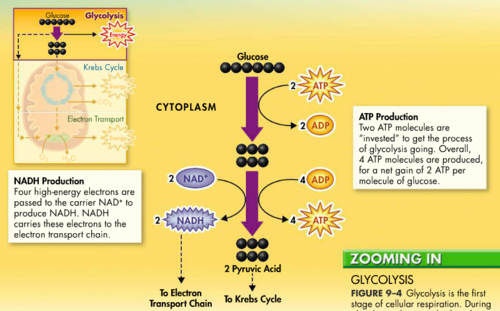
Alcoholic fermentation (yeast)
Yeasts and a few other microorganisms use alcoholic fermentation, which produces ethyl alcohol and carbon dioxide
Lactic acid fermentation
Most organisms carry out fermentation using a chemical reaction that converts pyretic acid to lactic acid
Quick energy- for short, quick bursts of energy, the body uses ATP already in muscles as well as ATP made by lattice acid fermentation
long-term energy
For exercise longer than about 90 seconds, cellular respiration is the only way to continue generating a supply of ATP

Chapter 9 & 10: Photosynthesis/Cellular Respiration >
Photosynthesis
Photosynthesis is a process that harnesses energy from the sun to convert it into energy-containing substances that can be used for fuel. One of the most essential substances that cells use to store and release energy is called adenosine triphosphate, or ATP. It consists of adenine, ribose (5-carbon sugar), and 3 phosphate groups.

Adenosine diphosphate is a compound similar to ATP, but it has 2 phosphate groups instead of 3. When a cell has available energy, it can store small amounts of it by adding phosphate groups to ADP to produce ATP. This energy can then be released by breaking the chemical bonds in the 2nd & 3rd phosphate groups. So basically, ATP is like a rechargeable battery.
In summary, ATP is like a fully charged battery, while ADP is partially charged, and can be charged when phosphate groups are added.

ATP is used for carrying out active transport, such as with sodium-potassium pumps, where membrane proteins pump sodium ions out of the cell, and potassium ions into it. ATP is also the motor for contracting muscles such as the wavelike movement of cilia and flagella, as well as the light of a firefly.
“In the process of photosynthesis, plants convert the energy of sunlight into chemical energy stored in the bonds of carbohydrates.”
Chlorophyll and Chloroplasts
Photosynthetic organisms capture energy from sunlight with pigments-- principally with chlorophyll,
which reflects green light, but absorbs light from other regions in the visible spectrum.
Accessory pigments reflect colors in other areas of the spectrum such as orange and red (helping chlorophyll maximize the amount of light energy absorbed from the sun), which is why these colors appear in fall.

Thylakoids are saclike chlorophyll-containing membranes, and in a stack, are referred to as grana. The fluid within the chloroplast is known as the stroma.
Electrons produced by chlorophyll require a special "carrier" called an electron carrier, a compound that accepts electrons and transfers them (and their energy) to another molecule.
NADP+ (nicotinamide adenine dinucleotide phosphate) is one of these compounds, which holds two electrons and a hydrogen ion in order to convert it into NADPH. With this, energy from sunlight can be trapped in chemical form, and the high-energy electrons can then be used to build sugars.

Photosynthesis uses the energy of sunlight to convert water and carbon dioxide (low-energy reactants) into high-energy sugars and oxygen (products) ……………..
Photosynthesis involves two sets of reactions:
Light-dependent reactions
require the direct involvement of light and light-absorbing pigments
Light-independent reactions
use ATP and NADPH molecules produced in the light-dependent reactions to produce high-energy sugars from carbon dioxide 
Light-dependent reactions use energy from sunlight to convert ADP and NADP+ into the energy and electron carriers ATP and NADPH. These reactions also produce oxygen as a by-product. Thylakoids contain clusters of chlorophyll, known as photosystems, which are surrounded by accessory pigments. These photosystems absorb sunlight and generate high-energy electrons that are passed to electron carriers within the membrane. Photosystem II (despite its name, this process occurs before photosystem I since it was discovered after), is where light-dependent reactions begin. Light is absorbed, raising electrons to a higher energy level, which are then passed to the electron transport chain. As these electrons continue to pass, the thylakoid membrane is able to provide new electrons (to replace the ones lost) from water molecules.

Light-independent reactions (Calvin cycle) then use the ATP and NADPH molecules to produce high-energy sugars from CO2.
-Energy for this process is supplied by compounds from light-dependent reactions. Six molecules of CO2 are used to produce a single 6-carbon sugar molecule.


Chemiosmosis is when H+ ions (from split water) that have been pumped into the thylakoid space have been accumulating so that there is an uneven concentration.
Carbon-Fixation is when CO2 is added to organic compounds. First, CO2 enters the stroma, and rubisco (enzyme) combines the CO2 with a 5-C sugar (Ribulose biphosphate, RuBP), this then creates a 6-carbon compound. This cycle occurs 6 times.
Inputs | Outputs | |
|---|---|---|
Light Independent (stroma) | ATP, NADPH, CO2 | Sugar |
Light Dependent (thylakoid membrane) | Light, H2O | NADPH, ATP, O2 |
Cross Section of a Leaf

Stoma: openings are holes in the bottom of the leaf, guarded by guard cells. They control whether or not the holes stay open or if they’re going to shut (water pressure allows this to happen).
On a dry day, these holes fill with water and close to prevent additional water lost
On a moist, humid day, these openings will stay open so the water in the air can enter, and oxygen can leave
Xylem tissue distributes water/minerals from the roots to various areas of the plant, and the phloem carries food from the leaves to the roots: water goes down, and food goes up.
Cellular Respiration
When transferring electrons and when molecules are receiving electrons, its called a redox reaction


An electron transport chain is a controlled passing of electron
Series of molecules that excited electrons pass along to release energy
Releasing energy pumps proton into thylakoid space
Photolysis
splitting of water during photosynthesis
H2O>O+2H++2e-
electrons go to photosystems, protons stay in thylakoid space, oxygen is released as a waste product
photosystem I is the rest station to boost the energy level so it can go down the next step of electron transport chain
Photostbtgesus Ciebxyme
Ferrodoxin transfers electrons to the NADP+ in the stroma
Carrier ion
Picks up H+ and excited electrons from ETC to become NADPH
Identify how organisms get energy
How does cellular respiration work?
Process of energy conversion that releases energy from food in the presence of oxygen
The chemical summary of cellular respiration is Oxygen + Glucose > Carbon Dioxide +Water + Energy
6O2+C6H12O6 > 6CO2+ 6H2O + Energy
Enzyme controlled reactions that allow the slow release of glucose so that you dont burst into flames when you eat
Glycolysis
enters a chemical pathway known as glycolysis. A small amount of energy is released
Krebs Cycle
A little more energy is converted form the carbon sugars, releasing the energy in the form of ATP, Co2 is the waste
Occurs inside of the mitochondria, specifically the matrix
Electron Transport
Inner membrane, where the proteins in the electron transport chain is found
using oxygen, water is produced
majority of the ATP made

Photosynthesis and cellular respiration can be though of as “opposite processes” (mrs Alvarez disagrees when it is worded this way), the products of one become the reactants of the other
Integral part of the carbon cycle

Oxygen + glucose > carbon dioxide + water + energy
Respiration requires a cell to exchange gases, we need oxygen within the cell, and carbon dioxide is produced as a waste.
Respiration: breathing on macro scale
Cellular respiration we have two different processes, based on whether or not they require oxygen to occur
Aerobic
Where it all happens (mitochondria)
Matrix- mitochondria’s cytoplasm
Glycolysis happens in the cytoplasm, anarobic
Formation of acetylyclA cytoplasm to matrix
Citric Acid Cycle (Krebs) occurs in the mitochondria matrix
ETC (inner membrane_
chemiosmosis
Using a protein gradient that we built up to pass it down
Store energy atp- adenosine triphosphate
collect hydrogen: Nadh- nicotamide adenine dinuceuotide
FADH2
Redox Reactions
Oxidation-reduction reactions transfer electrons from 1 substance or another glucose is oxidized during cellular respiration losing electrons to oxygen
Oxygen is reduced during cellular respiration accepting electrons and hydrogen from glucose
(glucose: oxidized, oxygen: reduced)
Anaerobic- Glycolysis
Step 1: Glycolysis
Series of 10 enzymes catalyzed reactions
Single glucose split into 2 pyretic acid molecules
One 6-C sugar > two 3c sugars
2 categories of reactions -use app, yield app and NADH
Anaerobic, occurs in the cytoplasm
An energy-releasing process uses 2 App reduces 2 Arp and 2 NADH
one reaction removes 4 electrons and passes them to NADH (each NADH accepts a pair of electrons
Very fast and doesn’t require O2
Reactants: glycose 2 atp
Products: 2 pyretic acid, 2 NADH, 4 ATP
Next step: 90% of energy in glucose still unused
so the acetyl CoA bridge helps us break it down further
2 pyretic acid molecules enter bridge
-cytoplasm > Matrix
Degraded by removal of C
Creates acetic acid
Combines with Coenzyme
Forms complex Acetyl CoA
starts with 2 pyruvates
ended with acetyl
2 co2
2 NADH
Step 3 Krebs cycle
Series of eight enzyme controlled steps
formation of oxaloacetate and citric acid
Final stage in the oxidation of carbohydrates, 2 acetyl coA enter cycle, one at a time
coenzyme a released
acetyl combines with oxaloacetate, making citric acid
Reactants: Acetly Coa
Products:
Where did all the H+ (NADH and FADH molecules) go?
step 4: electron transport chain
-series of molecules that excited electrons pass along, to release energy as ATP
ETC: moving from carrier to carrier > release energy
H+ ions are pumped for matrix into the intermembrane compartment: electrochemical gradient
ETC and chemiosymosis sumamry
start= 10 NADH, 2 FADH
end= 30 ATP, 4 ATP
Mitochondria and Inner membrane-
Fermentation: In the absence of oxygen, fermentation releases energy from food molecules by producing ATP, this happens until cellular respiration can happen again

Alcoholic fermentation (yeast)
Yeasts and a few other microorganisms use alcoholic fermentation, which produces ethyl alcohol and carbon dioxide
Lactic acid fermentation
Most organisms carry out fermentation using a chemical reaction that converts pyretic acid to lactic acid
Quick energy- for short, quick bursts of energy, the body uses ATP already in muscles as well as ATP made by lattice acid fermentation
long-term energy
For exercise longer than about 90 seconds, cellular respiration is the only way to continue generating a supply of ATP

 Knowt
Knowt